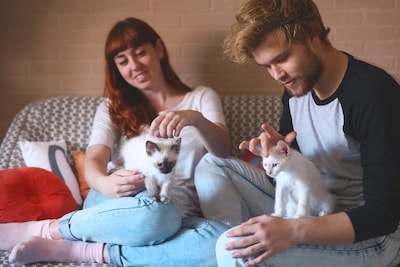In this article
- What is “littermate syndrome” in cats?
- Is it good to adopt two cats from the same litter?
- Is there an ideal age to separate kittens from a litter?
- How to prevent littermate syndrome symptoms in cats
- What to do if your cat is showing signs of littermate syndrome
- The bottom line on littermate syndrome in cats
Are your kitten siblings having trouble getting along with other pets or humans in your house? Do they show signs of stress when separated? Cat owners looking for answers may be tempted to group these behaviors as signs of “littermate syndrome,” a disorder in which kittens from the same litter will not form relationships with other members of their new family because they have grown so close that they are dependent on one another and fearful of new interactions.
But pet caregivers shouldn’t be so quick to blame a strong sibling bond for signs of stress and behavioral issues in cats, according to experts we spoke to. Here, they explain the real cause of “littermate syndrome” symptoms in cats and offer science-backed solutions for socializing kittens so they can be happy in any environment.
Key takeaways
- Some experts think “littermate syndrome” in cats is a myth and that behavior issues usually stem from poor early socialization.
- Kittens need positive exposure to people and pets between 2–9 weeks old.
- With the right support, sibling cats can live happily with others.
What is “littermate syndrome” in cats?
“Littermate syndrome” is a condition that makes it hard for bonded kitten siblings to socialize happily with others. But the truth of the matter is that veterinary behaviorists do not recognize it as an official syndrome, according to Ilona Rodan, a doctor of veterinary medicine and American Board of Veterinary Practitioners feline specialist. In fact, there is no scientific evidence at all that suggests a strong littermate bond is the root cause of any behavioral issues in cats.
So, why do some kitten siblings have a hard time bonding with other pets or humans? “Whether kittens are adopted as singles or as siblings, they will have difficulty bonding with other cats and other species, including humans, unless they have been socialized to that species at a young age,” says Rodan.
The most crucial time to socialize kittens with other animals and humans is between the young age of 4-8 weeks, notes Rochelle Guardado, certified cat behavior counselor and animal training manager at Pasadena Humane. This “socialization window” is when cats learn healthy — or unhealthy — social behaviors based on their experiences.
If kittens have positive experiences with other cats and humans during this time, they will be more likely to have positive bonds in the future. However, if your kitten experienced stress in their early socialization period, they are more likely to have trouble bonding with others, suffer anxiety or have general behavioral issues, explains Guardado. These issues are often mistaken for signs of “littermate syndrome,” but they can occur in both single and sibling cats.
Is it good to adopt two cats from the same litter?
Yes, it is ideal to adopt already bonded littermates, according to Rodan.
“The benefits of adopting two kittens from the same litter is that they are likely to have already formed a bond, showing affectionate behaviors towards each other,” Rodan says. “They are more likely to remain socially bonded throughout life.”
Have a senior cat? The benefits of adopting younger littermates can be even bigger. “Being the same age, the kittens are more likely to have similar play drives,” Rodan says. “If people have a senior cat and feel they must adopt, adopting sibling kittens gives them the ability to play hard together instead of bothering the older cat.”
Is there an ideal age to separate kittens from a litter?
“From birth on, kittens are continually learning from the queen, or mother cat, and their siblings,” Rodan says. “Ideally, kittens should remain with their siblings until 10 to 12 weeks of age. Breeders often prefer to keep kittens with the queen and siblings until 14 or 16 weeks of age. This improves physical health and allows for continued learning.”
But every situation is unique, explains Guardado. “Depending on the individual’s behavior, the environment in which they are learning, and the temperament of the queen, the ‘ideal’ time could vary from kitten to kitten,” Guardado says.
For example, if a kitten is growing up in a shelter environment, the benefits of keeping them with their littermates does not outweigh the risks of continuing to grow up in a stressful environment, Guardado explains.
“Whether [kittens] form relationships with others is not based on the kittens’ relatedness, but rather whether they were socialized to people, other cats, and other species early in life with positive experience.”
— Ilona Rodan, American Board of Veterinary Practitioners feline specialist
How to prevent littermate syndrome symptoms in cats
“Whether [kittens] form relationships with others is not based on the kittens’ relatedness, but rather whether they were socialized to people, other cats, and other species early in life with positive experiences,” Rodan says. Here are the best ways to set cats up for social success.
Consider adopting a kitten in foster care
“Kittens that will be adopted into a home must also learn from positive experiences with different people, especially between 2 to 9 weeks of age,” Rodan explains. “Foster care of non-purebred kittens found early in life allows the kittens to learn from siblings, while also learning about people and the home environment, reducing the likelihood of fear or anxiety later in life.”
Socialize kittens early and reward positive experiences
According to the American Veterinary Medical Association, there are a number of things you can do during your cat’s early life to encourage healthy socialization behaviors. Here are their top kitten socialization tips:
- Expose your kitten to the animals, individuals, environments, activities and objects that will be part of their new life early on
- Provide diverse play and interactions to encourage your cat to enjoy new experiences without becoming fearful or aggressive
- Give plenty of praise, playtime and treats to reward positive engagement
Boost their individual independence
Guardado recommends letting kitten siblings spend time apart from each other for short stretches in order to build resilience and confidence. Prioritizing activities like individual interactive playtime and carrier training, or teaching your cat that their personal carrier is a safe, comfortable space so they enter voluntarily, will have lasting benefits for your kitten into adulthood, she explains.
“Each kitten will likely have their own personality and therefore prefer different styles of play,” Guardado says. “Giving them a chance to engage in daily enrichment activities both alone and together can build up a kitty’s confidence.”
Create an environment that meets the needs of every cat
“Reducing stress and anxiety for household pets often starts with providing a bountiful and engaging daily routine,” Guardado says. Daily routines for cats should include physical and mental enrichment activities, like toys and training time, as well as access to individual resources like a litter box, food, water and safe spaces where cats can withdraw to be alone if they feel uncomfortable, she explains.
With this in mind, one of the best ways to prevent stress and conflict between new kitten siblings and other cats is to dedicate even more space in your home to basic cat needs and activities so that they do not feel the need to compete for these resources which can cause conflict, Guardado explains. “For example, you’ll need plenty of space for multiple litter boxes, vertical climbing spaces, warm cat beds, as well as separate feeding and hydration stations,” Guardado says.
Gradually introduce kittens to other cats
When introducing new kittens to a household with a cat, the key is to go slow, according to the experts we interviewed. A couple of must-knows when it comes to how to introduce cats to each other:
- Keep new kittens in a separate location with their own resources for at least one to two days before allowing them to share space with existing cats.
- Slowly introduce them to each other in stages. The first stage should be scent, second visual contact and third physical contact.
“Generally speaking, introducing a kitten to an adult cat is usually easier, especially if the older cat has had previous successful interactions with cats and kittens,” according to Crista Coppola, who holds her doctorate in animal sciences and is a certified cat and dog behavior specialist with Senior Tail Waggers. “But the same precautions and steps should be used.”
“Mental and physical health go hand in hand. If you witness stress in your cat or suspect their behavior is changing, write down your observations or collect a video log to show your veterinarian.
— Rochelle Guardado, certified cat behavior counselor
What to do if your cat is showing signs of littermate syndrome
“Mental and physical health go hand in hand,” says Guardado. “If you witness stress in your cat or suspect their behavior is changing, write down your observations or collect a video log to show your veterinarian. Separation anxiety should only be diagnosed by a licensed veterinarian or veterinary behaviorist.”
Once your veterinarian has diagnosed any behavioral disorders which may include conditions such as aggression, separation anxiety or noise phobia, a certified cat behavior consultant can then help you better understand your cat’s needs and provide training that can help ease these issues, Guardado adds.
The bottom line on littermate syndrome in cats
According to experts, strongly bonded kitten siblings who are fearful or aggressive toward other cats and humans are not suffering from “littermate syndrome” but rather behavioral issues born out of negative experiences that likely occurred between 2-9 weeks of age. The good news? These signs of “littermate syndrome” can be avoided:
“Whether a single cat or siblings, remember to socialize kittens to others early on,” advises Rodan. “If that has not happened, make sure older kittens or adult cats only have positive experiences with people and whatever other species they will live with. Go slowly with introductions and reward all calm and happy interactions.”





